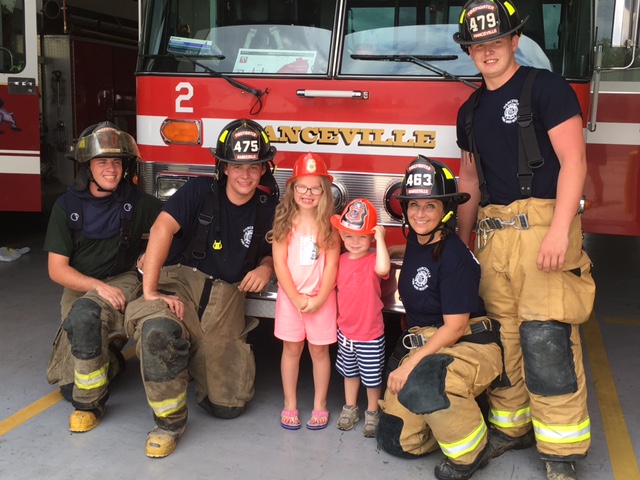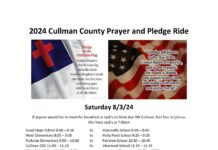Firefighters take time out of a busy training day to welcome young visitors. / W.C. Mann
HANCEVILLE – Hanceville Fire Station No. 1 was a popular place to be recently, as the Hanceville Fire Department (HFD) held vehicle firefighting and victim extrication exercises as part of its ongoing firefighter training program. And it wasn’t just firefighters who were showing up.
The HFD is currently conducting Firefighter Two training, building on its recently completed beginners’ Certified Volunteer Firefighter course, also known as the “160” course for the number of hours involved. Eight firefighters completed the 160 class out of 18 enrolled. Those eight have been joined by 10 others who had previously completed the course, to begin the next phase of their training.
On Saturday, instructors and trainees arrived at the fire station as early as 6 a.m. for classwork and testing, before putting on up to 80 pounds of turnout gear and heading outside into a warm and humid June morning to practice putting out vehicle fires and try their hands with the “jaws of life” by cutting up real cars.
HFD Capt. Jacob Hudson, who is in charge of the training program, sat down with The Tribune during a break in Saturday’s activities to talk about the completion of 160 and the start of Firefighter Two.
“It’s pretty typical to lose a lot of students. It’s not uncommon to start with 25 or 30, and graduate six to ten. And it’s not so much the physical demand of the course–that has a lot to do with it–but it’s also anywhere from four to six months’ worth of training, two or three days a week, and a lot of people’s personal lives and work make it hard for them to be there that long.
“The Certified Volunteer Firefighter is the entry level: the basics of firefighting that gives them enough knowledge to hopefully go back and perform the job safely and efficiently under the guidance of more seasoned firefighters in their departments.”
According to Hudson, Firefighter Two “takes all the knowledge that they’ve learned in 160, and gears them up to go to the next step in leadership roles in their departments. At this point, they can take a bridge program that is five weeks long, that will bridge them over into the career side of firefighting, if they choose.”
The advanced course includes studies in firefighting and rescue techniques, as well as administrative activities that go into keeping a department or station in good working order: testing fire hoses, maintaining equipment, use of fire suppression foams, vehicle extrication, presenting fire safety programs to one’s community, developing pre-fire plans and performing home and business fire inspections.
Kaleb Jones, a firefighter from the Gold Ridge Volunteer Fire Department, is enrolled in the course. He talked about his experience in 160, and what he’s doing now.
“It (160) was a lot harder than I was expecting, but it was a lot of good information. I learned a lot of things through it that I didn’t know previously. It showed me how to be safer in what we do. I want to follow up, and take as many classes as I can take, and I plan to stay and take them here at Hanceville. I love the instructors here; they do a great job.”
The Hanceville HFD training program has become a popular stop for firefighters from all over the area, and not just from Cullman County. The department’s reputation for quality instruction drew Jamie Bishop, the first-ever female Chief of Dallas-Selfville Fire and Rescue, who came with crew members from her community in south Blount County. Though a chief, she is enrolled in the course herself, getting as hot and tired as the rest of her crew.
Bishop shared, “I can’t really ask my guys to come do training in things that I don’t already have, so I feel it’s only fair that I do what I ask them to do.”
When asked about the training, she responded, “I love it, I enjoy it. I really do. I look forward to getting my Firefighter Two; and then any other classes (Hudson) puts on, I fully intend to be in, too.”
The popularity of Hanceville as a training center, and participants’ intent to return to this place for future courses, was a common theme in conversations Saturday.
Hudson reflected on the draw that his department has created, “We really strive here, and it’s our mission to provide training that’s low-cost, if not free when possible, to volunteers. They’re already volunteering their time, they’re volunteering their gas, they’re taking time away from their families to go out and protect their communities.
“We’re a combination department. We have some full-time guys, but without these volunteers we wouldn’t be what we are. There’s no way. Volunteers are the backbone of our department, and they’re the backbone of so many communities. They go unnoticed and unthanked so often. Why wouldn’t I, and why wouldn’t we, as a department, want to offer them a chance to get an education so they can go back and teach the same things in their communities and make all their members operate more efficiently and safely, and also make their communities safer because of that?”
Being a firefighter isn’t all about fighting fires
At noon the firefighters, most of whom had been onsite for six hours already, finished up one round of fire suppression exercises on burning cars in the field behind the station. Dismissed for a lunch break, they were stripping off their heavy turnout gear when someone noticed a family out on the street that had stopped to watch the exercise. Among the family’s children was a young boy who was celebrating his birthday and wearing a toy fire chief’s helmet he had received as a gift. He had told his parents he wanted to meet a firefighter, so they stopped by.
Several of the exhausted firefighters, who had just been presented with the promise of hot lunch in the cool indoors, grabbed their helmets and went out to meet the family and pose for pictures with the kids. After that, the children got to sit in the driver’s seat of an HFD truck and blow the giant air horn before receiving coloring books and souvenir helmets from HFD Chief Rodger Green and his crew.
Then the firefighters finally got to enjoy their lunch, having practiced extrication and fire suppression, and having demonstrated how emergency responders, even without a fire hose or paramedic kit bag, can still be someone’s hero.
Background reading on the 160 training: http://qrne.ws/hfd
Copyright 2017 Humble Roots, LLC. All Rights Reserved.



























